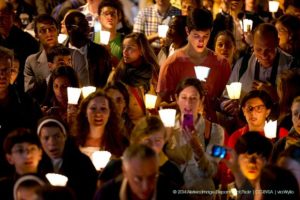 We all know the statistics describing congregational decline, and they are sobering. Every congregation is in dialogue about whether they will be part of the decline, or whether they will plan for a more vital future. Congregations create strategic plans to prevent, ward off, or reverse declining trends. Will the plans that we make stem the tide and make a difference? Are we on the right strategic pathway?
We all know the statistics describing congregational decline, and they are sobering. Every congregation is in dialogue about whether they will be part of the decline, or whether they will plan for a more vital future. Congregations create strategic plans to prevent, ward off, or reverse declining trends. Will the plans that we make stem the tide and make a difference? Are we on the right strategic pathway?
Most planning conversations focus on reaching the lost generations (Gen X and the Millennials). Leaders read the latest research and talk about their understanding of what younger people seek in a faith community, and what keeps them away. Then leaders claim new strategic priorities that they believe will make the biggest difference for a more vital, multi-generational future.
My concern is that most congregations are claiming the same few strategic priorities, and I don’t see how these priorities will take us where we need to go. I consistently encounter churches claiming a brighter future through better programs for children, youth & families, and alternative worship choices. Under the guise of new and fresh thinking, today’s solutions seem to embrace our historical success. Is this really our best way forward?
Don’t get me wrong. I’m all for strengthening programs for children, youth and families. And, research from Faith Communities Today reveals that adding innovative and contemporary worship has historically paid growth dividends. However, I am fearful that our investment in these program areas will distract us from doing the real work that is needed.
All of our activity is based on the underlying assumption that finding the right way of “doing” church will redevelop vitality. And yet, millennial voices like Rachel Held Evans consistently tell us that our disengaged generations are not interested in “doing” church. They are invested in “being” the church.
The illusive quality of vitality that we are chasing has less to do with the form or style of worship that we offer, and more to do with creating an authentic experience of being in God’s presence. Our missing generations are not attracted to more programs to make their lives even busier; they are attracted to being an authentic community that engages life together, informed by shared values and faith practices.
How do we create strategic plans that take us away from doing more programs and toward a more authentic expression of being? This is tricky, because strategic planning by its very nature is doing oriented.
We must begin with a resolve to stop throwing program-oriented solutions at our perceived gaps. We must get clearer about the outcomes (changed attitudes and behaviors) we seek, and we must name observable and measurable indicators that will help us monitor progress.
Are we becoming more vulnerable with one another and more empathetic toward others? Are we sharing our spiritual journeys? Are our prayer lives deepening? Are the life choices we make, how we spend our time and money, reflecting our shared values? What evidence would we see if these things were happening? What barriers stand in the way? What can we do to diminish or remove those barriers? These are the action plans we ought to pursue.
We need to quit acting as if faith formation is something that the church does with children, on behalf of their parents, and we must re-orient ourselves toward becoming partners in faith formation alongside our parents, resourcing and encouraging them to be the primary discipleship mentors of their own children.
We need to teach, model and nurture spiritual discipline. We need to reflect on what worship means and what makes it authentic, and then work towards creating more of those experiences in our present venues, without getting sidelined by debates about musical instrumentation and style choices.
Finally, we must quit running our organizational life as if the congregation were soul-less. We must recognize that the spiritual formation of our leaders is inextricably linked with the soul of the institution, and that practices for listening to the soul of the institution need to be nurtured. Otherwise, we will continue to chase flavor of the month programming that produced vitality somewhere else, without stopping to consider what the soul of THIS congregation requires.
Congregations that are trying to “be” different require strategic planning every bit as much as congregations that are trying to “do” different things. However, the nature of those two types of plans are quite different. Which kind of plan are you pursuing?
